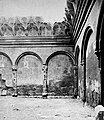Horomos Monastery
History
Horomos was founded by a group of Armenian monks around 931-36, during the reign of King Abas I Bagratuni (r. ca. 929-953). The monastic complex was enlarged over time and came to include the individual churches of Sts. John, Minas, and George, a series of large halls (gavits), a triumphal arch, and various smaller chapels and mausolea. It served as a burial ground for noble families, particularly Ashot III of Armenia (r.953–77), Gagik I of Armenia (r.989-1020), Yovhannēs-Smbat, and the Zakarids in the 13th century, and is a sort of Armenian "Saint-Denis".
Church of Saint John (1038)
The Church of Saint John ("Surb-Yovannēs"), now in a highly ruined state, was built by King Yovhannēs-Smbat, son of Gagik I of Armenia, in 1038, according to an inscription.
Zhamatun of Saint John church (1038)
The zhamatun of Saint John church is the first known instance of a zhamatun or gavit in Armenia, an architectural element built in front of the church for gathering purposes. It is dated to 1038, and was built by King Yovhannēs-Smbat, son of Gagik I of Armenia. It was already called "žamatun" per the 1038 dedicatory inscription:
In the year of the Armenians 487 (ie 1038), I, the šahanšah Yovannēs, son of the šahanšah Gagik, gave my vineyard located in Kołb to this church of mine, Surb-Yovannēs (Saint John), which I have built in this monastery of Hoṙomos, along with this žamatun...
— Dedicatory inscription of the gavit at Horomos.
The tomb of King Yovhannēs-Smbat is located here.
-
Inside the zhamatun
-
Pillars of the zhamatun, and octagonal vault, featuring "The Tetramorphic Throne and the Last Judgement".
![The zhamatun with its colonnaded belvedere covering the hole of the oculus.[7]](http://upload.wikimedia.org/wikipedia/commons/thumb/5/51/Horomos_Monastery_42.jpg/200px-Horomos_Monastery_42.jpg)

![Pillars of the zhamatun, and octagonal vault, featuring "The Tetramorphic Throne and the Last Judgement".[8]](http://upload.wikimedia.org/wikipedia/commons/thumb/4/43/Horomos_Monastery_26.jpg/200px-Horomos_Monastery_26.jpg)


![Horomos Monastery: St. John's zhamatun and church. Photo T‘oros T‘oramanean, 1910s.[22]](http://upload.wikimedia.org/wikipedia/commons/thumb/a/af/Horomos_Monastery_St._John%E2%80%99s_zhamatun_and_church._Photo_T%E2%80%98oros_T%E2%80%98oramanean%2C_1910s.jpg/120px-Horomos_Monastery_St._John%E2%80%99s_zhamatun_and_church._Photo_T%E2%80%98oros_T%E2%80%98oramanean%2C_1910s.jpg)











![Zhamatun topped by a colonnaded canopy.[23]](http://upload.wikimedia.org/wikipedia/commons/thumb/5/51/Horomos_Monastery_42.jpg/120px-Horomos_Monastery_42.jpg)



![Inside the zhamatun of Saint John church (1038).[23]](http://upload.wikimedia.org/wikipedia/commons/thumb/e/ef/The_Monastery_of_Horomos_%28Ghoshavank%29_%284218808492%29.jpg/120px-The_Monastery_of_Horomos_%28Ghoshavank%29_%284218808492%29.jpg)
![Inside the zhamatun.[23]](http://upload.wikimedia.org/wikipedia/commons/thumb/a/a7/Horomos_Monastery_36.jpg/120px-Horomos_Monastery_36.jpg)
![Inside the zhamatun.[23]](http://upload.wikimedia.org/wikipedia/commons/thumb/0/06/Horomos_Monastery_40.jpg/120px-Horomos_Monastery_40.jpg)



![Inside the zhamatun of Saint John church (1038).[23]](http://upload.wikimedia.org/wikipedia/commons/thumb/c/c9/Horomos_Monastery_06.jpg/67px-Horomos_Monastery_06.jpg)
![Inside the zhamatun of Saint John church (1038).[23]](http://upload.wikimedia.org/wikipedia/commons/thumb/5/59/Horomos_Monastery_07.jpg/120px-Horomos_Monastery_07.jpg)

![Dedicatory inscription for the gavit, by King Yovhannēs-Smbat in 1038.[5]](http://upload.wikimedia.org/wikipedia/commons/thumb/7/71/The_Monastery_of_Horomos_%28Ghoshavank%29_%284218753352%29.jpg/120px-The_Monastery_of_Horomos_%28Ghoshavank%29_%284218753352%29.jpg)



